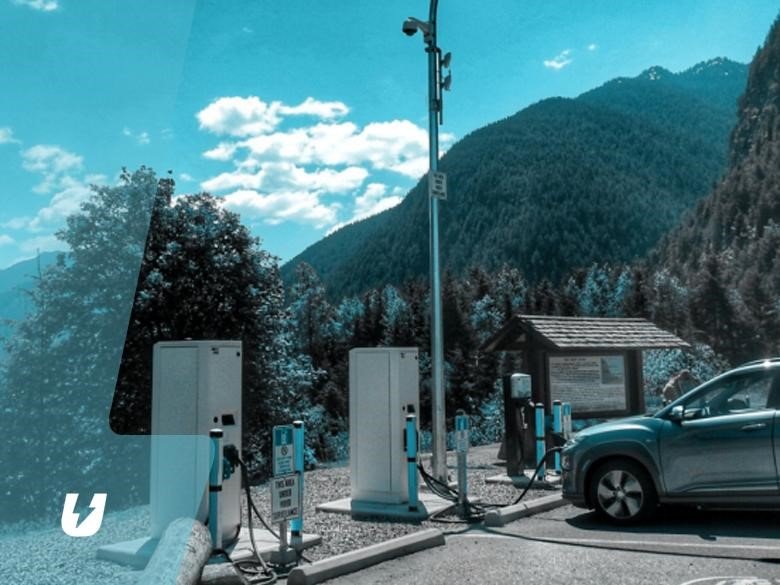While more and more charging stations are being installed throughout the UK, there are still places where they are unavailable. Thus, you must know how long it takes to charge your vehicle to avoid wasting time or running out of battery on the road.
How long does an electric car take to charge? How far do electric cars travel on one charge? How can you optimize drive time at every charging station? These questions don’t have easy answers, so take the time the read this article in order the understand the details.
Home Charging
There are two ways for car owners to charge at home – using a sturdy wall box or a three-pin plug socket.

A domestic socket is good for occasional or emergency use but a wall box delivers faster and safer EV charging. If you don’t have one, it would take more than a day for you to charge an electric vehicle with a big battery.
Pod Point, a provider of wall box chargers, offers online EV charging time calculations of various electric cars with their three power outputs. They posted the following times with the Renault Zoe:
- 2.6kW – 7 hours and less
- 7kW – 4 hours and less
- 22kW – 2 hours and less
Charging overnight at home remains one of the most convenient and reliable methods of charging every day for local driving.
Public Charging
These are the charging speeds you will find at the following electric car charging stations.
Non-rapid Charging (6-12 Hours)
Slow chargers can be rated at 3kW or 7kW, while fast chargers can be rated up to 50kW. Beyond that already belongs to the category of rapid charging. Slow charging is generally linked to home charging, while 5.5kW is generally associated with a lamppost charge rating unit.
With a charge time of 12 hours, slow charging becomes unsuited for anything beyond home, hotel, or workplace utility. The Nissan Leaf with a 40kWh battery, for instance, is expected to reach full charge within six hours with a 7kW or 22kW charger.

Rapid Charging (20-60 Minutes)
A rapid 43kW AC charger can fully charge an electric vehicle in 20-40 minutes, depending on battery size and the charge state upon using the charging point.
Likewise, a rapid 50kW DC charger can recharge an 80 percent full battery within 20 minutes.
Ultra-rapid Charging (20-25 Minutes)
Ultra-rapid chargers provide 100kW power or more, generally at 100 kW to 350 kW. These chargepoints show the future of electric cars, using the current fast technology exclusive to the majority of expensive cars like the Porsche Taycan, BM! iX, and Audi e-Tron GT.
The Audi e-Tron GT, for instance, can reach full charge in just 25 minutes while connecting to an ultra-rapid charger, although this can increase to 9.5 hours with a non-rapid 11kW unit.
Even an electric vehicle capable of receiving 50kW maximum power can connect to an ultra-rapid charger, at a lower rate.
Tesla Supercharger (Below 40 Minutes)
Tesla supercharges can reach full charge in 40 minutes with a 150kW V2 Supercharger 130 V3. The number of Tesla V30 Superchargers with 250kW charging capacity is more than a hundred and these can charge at 1,000 miles added/hour.

Factors Affecting Charging Speed
An electric vehicle’s charging time is affected by these main factors.
- Battery size
How long does it take to charge a car battery? The bigger your car’s battery capacity (kWh), the longer it takes to charge. Generally, the car’s size is manifested by its battery size. The bigger battery generally equates to more range, although there may be a bit of a downside in terms of weight since bigger batteries are heavier – some over 500 kg.

Electric cars with smaller batteries would require more frequent charging compared to larger-battery cars. The Honda E is an example of a small battery car, with a 35.5kWh pack. A bigger car such as the Vauxhall Corsa-e contains a 50kWh battery pack, while the Volkswagen ID.3 possesses multiple battery options, ranging from 58kWh – 77kWh.
Stepping up the notch, the Porsche Taycan has battery sizes from 79.2kWh – 93.4kWh. Tesla embeds the Model S with a 100kWh battery pack, while the Rivian offers a 135kWhpack for the R1T pick-up truck.
An outlined plan was shared by General Motors which reveals future vehicles being fitted with 200kWh batteries, while Tesla has announced its Semi will contain a smashing 500kWh pack.
This may not seem like a big deal but it’s important to remember that there are car manufacturers who quote the usable capacity, and some that quote battery capacity. For instance, a Porsche Taycan’s largest battery has a 93.4kWh capacity and an 83.7kWh usable capacity. Such knowledge could prove useful if there seem to be conflicting numbers in the same car.
- Power Source
Electrical outlets are not created equal. The kitchen’s standard 120-volt; 15-amp receptacle, is a 240-volt outlet that supplies power to your electric dryer. Theoretically, all-electric vehicles can charge their batteries from a common kitchen outlet.

But think about it as filling a 55-gallon barrel with water using a squirt gun. Recharging an electric vehicle from a 120-volt power source (Level 1) will take days – not hours. As an electric vehicle owner, it is best to have a Level 2 (240 volts) charging station installed at home.
The standard Level 2 connector contains 240 volts and 40 amps. Lower amps can still be categorized as Level 2, and 40-amp circuits can still optimize an electric vehicle’s charger. If you are not optimizing the efficiency of your electric car’s onboard charger, a low-power source would become a restrictor that prolongs charge time.
To get the fastest charging, you must plug into a DC fast charger. This electric vehicle version connects the barrel to the fire hose. A lot of DC power is certifiably delivered into the vehicle’s battery, adding miles of range fast.
Tesla’s superchargers, for instance, supply about 250 kW. But just like any method of charging, the flow is inhibited back once the car’s battery reaches a low or high state of charge. An electric car’s ability to receive DC charging differs broadly.
The Porsche Taycan can reach up to 270 kW of charging, while the Chevy Bolt EV can charge up to 50 kW. If the vehicle’s SoC battery is lower than 20 per cent or more than 80 per cent, the charging rate of DC fast chargers slows down, optimizing battery life and limiting the likelihood of overcharging.
It’s the reason why manufacturers claim that fast charging gives you 80 per cent in half an hour. The final 20 per cent can increase significantly if you are connected to a fast charger. The optimized charging through a DC charger is what makes them ideal for charging more power to reach your destination but not exceeding your vehicle or chargepoint’s capacity.
Take a deep dive into the subject matter. Learn more by clicking here: AC vs. DC Charging
- Vehicle’s Max Charging Rate
What is the maximum charging rate of your vehicle? You can charge a car’s battery at its maximum charging capacity. If your car’s maximum charging rate is 7kW, it wouldn’t charge faster even if you use a 22kW chargepoint.

Understanding the amount of charge rate your vehicle can handle is crucial to determining the maximum power your car can get from any charger so you can avoid wasting time.
The battery state, whether low or high, is also another obvious factor to consider. The lower your battery state is, the longer it will take for you to charge than starting from a higher battery state.
The SoC or State of Charge is the charge percentage of your electric car’s battery once you pull out the charger. Electric cars get power at high rates between 20% to 80%, but if the battery charge state is below 20% or more than 80%, there will be a significantly slower charge rate.
This is because the car is protecting your battery. So before the charger and battery reach full charge, it will slow down charging to prevent unnecessary additional charges.
- Maximum Chargepoint Capacity
The chargepoint’s maximum charging capacity also limits the time it takes to charge your vehicle. For instance, even if you can charge your vehicle at 11kW, it can only each 11kW if you’re charging on a 7kW chargepoint.

Your charging time will always be affected by the charging station being used, whether it’s a fast, slow, or rapid charger. You may have a vehicle that charges very fast, but if your charger has a slower max charging rate, you’d still be restricted to a slower rate.
EVs must be charged through Direct Current or DC, so if you use standard socket charging (CA), the car will utilize the converter to convert power into DC.
There are also restrictions as to the amount of AC power you can supply your electric vehicle through a converter since these charging types generally reach maximum capacity at 22kWh in several electric cars, and low speeds such as 3.7 kWh in some.
- Environmental factors
A vehicle’s efficiency will depend on several factors including environmental like temperature. A colder temperature will make it a bit longer to charge, especially with a rapid charger. Vehicles also become less efficient at colder temperatures, such that fewer miles will be added per charging time while the station is being repaired.

Electric car batteries function optimally between 20 – 25 °C outdoor temperatures; so if temperatures begin to drop, the battery’s efficiency will drop as well. The battery will use part of the charge to produce energy and heat before it warms up to charge, which reduces charging speed.
Likewise, if the battery is heated up, your electric car will need more energy to lower the battery’s temperature, which also leads to a slower charging speed. Electric vehicles are more efficient and have better mileage per hour during the summer than in winter.
If you’ve driven your electric car before utilizing a rapid charger, your battery will probably have already reached optimal temperatures and won’t require any more energy to warm up. The electric car should be able to obtain power from the charger faster.
But suppose you’ve only done a short commute before reaching a rapid charger. In that case, the battery will probably be cooler and need more energy to reach an optimum temperature and charge faster.
Enjoy Great Charging Speed with a Quality Charger
The chargepoint you use is a huge factor in charging your electric car so make sure that you choose a good one. Pumpt.io is a provider of quality and affordable domestic wall boxes that provide great charging speed. Check out our product page for more detailed information about our excellent units.

